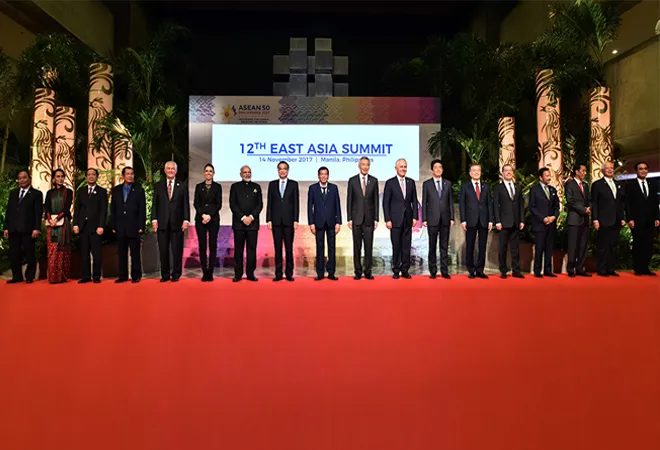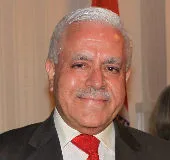-
CENTRES
Progammes & Centres
Location
Prime Minister Modi and the Indian foreign policy establishment can feel upbeat with the results of the visit.

The foreign policy community in India would have heaved a collective sigh of relief when Prime Minister Narendra Modi left Washington, DC after a two-day visit on 25 and 26 June without a snafu during his interactions with the new US President Donald Trump. What it would have found even more reassuring is that no untoward tweet from the US President chased PM Modi after his departure from the American shores.
The visit by Prime Minister Modi can be termed an unqualified success not only because the expectations which had been set quite low have been more than fully realised, but also because some significant decisions were taken during the visit and reassurances were received that the upward trajectory of bilateral ties will continue unabated.
Before the visit, commentators were looking at it with considerable anxiety, some hope and a little optimism. But now, it is heartening to note that optimism and hope has trumped over anxiety and uncertainty. Ministry of External Affairs itself had suggested that expectations should be kept modest. Several reasons can be adduced for that cautionary guidance. The most immediate was Trump's comment on 1 June 2017 while dumping the Paris Climate Accord that India had made its compliance with the provisions of the Paris Agreement contingent upon receiving billions of dollars from the international community.
Equally importantly, the conduct of the new occupant of the White House has not exactly inspired confidence in his understanding of global equations and US role in the rapidly evolving geopolitics. President Trump is seen as mercurial, unpredictable and impulsive. He is seen to change his positions very quickly without any sound, plausible reasons.
Donald Trump appears to be imbued with the messianic conviction that he should dismantle all that Obama had created.
He has been quite successful at that. There was serious anxiety whether Trump will reverse course on India-US relations which have witnessed a consistent and rapid upward trajectory over the last two decades.
All these doubts and apprehensions were squarely set to rest as Modi's entourage drove into the White House on the afternoon of 26 June to be warmly welcomed at the entrance by President Trump and the first lady Melania Trump.
The tone was set a day earlier when President Trump tweeted that he was looking forward to discussing strategic issue with a "true friend." PM Modi also responded immediately and equally warmly that he was looking forward to his talks with POTUS. The White House officials informed the media that a red carpet welcome would be accorded to PM Modi and that he would be the first foreign leader to dine with President Trump at the White House since the latter's assumption of office five months ago.
Before the commencement of the visit, it had been billed as a get-to-know each other meeting. It was suggested that no big-bang announcements should be expected as this visit was to develop a rapport and establish a healthy, comfortable relationship between the two leaders. This was the first face-to-face meeting between the two leaders although they have spoken to each other thrice on telephone.
The most significant result of the visit is that the two leaders were able to strike a warm, cordial and respectful relationship with each other. They exuded warmth and easy camaraderie and bonhomie with each other. The body language was reassuring and encouraging. The affability established between Modi and Trump inspires confidence that India-US partnership will continue to prosper in the coming years.
In substantive terms, the biggest takeaway is the naming of Syed Salahuddin, the 'supreme commander' of Kashmiri militant outfit Hizb-ul-Mujahideen as a Specially Designated Global Terrorist because he "vowed to block any peaceful resolution to the Kashmir conflict, threatened to train more Kashmiri suicide bombers, and vowed to turn the Kashmir Valley into a graveyard for Indian forces." It completely punctures Pakistan's claim that the Kashmiri unrest is home grown and that Pakistan is only lending political, moral and diplomatic support to the Kashmiri movement. This is a strong message to Pakistan and to the international community that the US is ready to take an uncompromising position against international terrorism. As expected it has hit Pakistan where it hurts the most. That is why it has responded in a seemingly indignant yet defiant manner.
The biggest takeaway is the naming of Syed Salahuddin, the 'supreme commander' of Kashmiri militant outfit Hizb-ul-Mujahideen as a Specially Designated Global Terrorist.
Although this can be construed as a significant move, it is a moot point as to what long term impact this will have on Pakistan's activities and policies. There have been other cases like those of Hafiz Saeed and Lashkar-e-Taiba who have also been given this designation by the US, but barring some random, intermittent steps, Pakistan has not changed its policy of supporting terrorism. The US will need to ramp up the pressure and ensure that Syed Salahuddin's activities are curtailed by Pakistan. Salahuddin has exhorted people in Kashmir to observe commemoration gatherings to mark the death anniversary of terrorist Burhan Wani on 8 July. The US should inform Pakistan in no uncertain terms that such activities by Salahuddin will not be tolerated.
The Joint Statement issued at the conclusion of the visit includes strong language against terrorism and expresses resolve of the two countries to act jointly against it. Two references to Pakistan have been made explicitly by name — one, to ensure that its territory is not used to launch terror strikes against other countries, and second, to expeditiously bring to justice the perpetrators of the 26/11 Mumbai, Pathankot, and other crossborder terrorist attacks. The statement names terrorist groups like LeT, JeM and others and exhorts the international community to take stringent action against them.
Some joint activities identified by the statement include increased intelligence sharing, operational-level counterterrorism cooperation, exchange of information on known and suspected terrorists for travel screening, strengthening information exchange on plans, movements and linkages of terrorist groups and their leaders, terror financing, expeditious conclusion of negotiations of UN Comprehensive Convention on International Terrorism, etc. The real test of commitments assumed by the two countries will lie in action taken by them in the coming months. Keeping in view the strong position of Donald Trump against global terrorism, there are better prospects today than any time in the past that suitable action will be taken by the two countries to quell this menace.
India can be satisfied that on the issue of regional connectivity, its position has been fully reflected. The statement declares need for transparent development of infrastructure and use of responsible debt financing practices, while ensuring respect for sovereignty and territorial integrity, the rule of law, and the environment. Also the position of the two countries on South China Sea (without mentioning it by name) including freedom of navigation, over flights, and commerce throughout the region; and need to resolve territorial and maritime disputes peacefully and in accordance with international law has been reiterated. This reaffirms that India and USA are on the same page as far as dealing with the rapidly growing influence and presence of China in the Indian Ocean and Indo-Pacific region are concerned.
Defence has emerged as a major area of cooperation with the US surfacing as the second largest supplier, second to Russia, of sophisticated defence equipment to India.
Sale of 22 surveillance Guardian drones is on the cards and is likely to be announced shortly. Also, reports have appeared about a possible tie-up between Lockheed Martin of the US and the Tata group to locally manufacture F16 aircrafts in India. Some concerns have been expressed regarding the obsolete technology of these planes. It is expected that officials of air force and others who are entrusted with this responsibility will pay due attention to these factors before giving the green signal.
It was feared before the visit that Trump looks at all ties with partner countries in transactional terms, in terms of creating jobs in the US, through the mantras of America First, Hire American Buy American, etc. It is satisfying to note that the Joint statement focuses on several issues of mutual strategic concern like South China Sea, Afghanistan, Pakistan, North Korea, etc. In addition, the statement contains reference to India's strong support for United States to join as an Observer in the Indian Ocean Naval Symposium as also the Malabar exercises between the US, India and Japan.
To assuage his domestic constituency, Trump announced in his statement to the press on 26 June that an Indian civil aviation company had decided to place orders for 100 civilian planes for USD 22 billion. This would create several thousand jobs in the US. Sale of 22 Guardian surveillance drones will add another USD 2-3 billion to US exports to India.
The issues of H1B visas and the Paris Climate Accord do not find a mention in the statement. Discussions on these issues at ministerial and senior official level would have taken place. PM Modi in his Article in the Wall Street Journal (WSJ) on June 25 categorically states: "
The Joint Statement contains reference to a comprehensive review of bilateral relations and to further expanding and balancing trade relations on the principle of free and fair trade. Trump in his statement to the press also referred to the need for a fair and reciprocal trading partnership between the two countries. To respond to Trump's concerns about creating jobs in the US, Modi in his WSJ Article has mentioned that Indian investment of USD 15 billion in the US is creating jobs in 35 US states, including in the rust belt from where Trump received huge support in his election. Trump in his statement expressed appreciation and gratitude for the defence purchases by India as also of 100 airplanes by a civil aviation company and about the projected supply of gas by the US to India. This and clean coal and renewable energy resources and technologies will significantly add to India's energy security.
An additional aspect of the visit was the reach out to the family of Donald Trump by PM Modi. He invited Trump's daughter Ivanka to lead a delegation of US entrepreneurs to a Global Meet in India later this year. Trump specifically referred to this in his Rose Garden address implying that this initiative had immensely pleased him.
Prime Minister Modi and the Indian foreign policy establishment can feel upbeat with the results of the visit. Given the uncertainties that had been plaguing the journey for the last few weeks, the results have been nothing less than gratifying. PM Modi wrote in his op-ed piece in WSJ that a year ago while addressing the US Congress, he had spoken about having overcome the “hesitations of history.” He affirmed that a year later, he is confident of the growing convergence between the two nations. Prime Minister Modi's visit has set the stage for rapid and robust growth in multi-faceted ties between India and the US in the coming years.
The views expressed above belong to the author(s). ORF research and analyses now available on Telegram! Click here to access our curated content — blogs, longforms and interviews.

Amb. Ashok Sajjanhar has worked for the Indian Foreign Service for over three decades. He was the ambassador of India to Kazakhstan Sweden and Latvia ...
Read More +